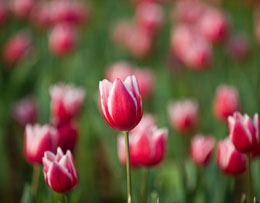The life cycle of tulips starts when the bulbs are planted from mid-September to mid-November, and ends when the leaves fade and wither away. This Buzzle article provides information about the life cycle of these beautiful, cup-shaped flowers.

Tulips were considered to be the flowers of God by the Turks due to their beauty and perfection. It is a misconception that this flowering plant is a native of Holland. Contrary to the belief, there is not a single species of tulip that is native to Holland. They belong to Central and Western Asia, and were brought to Turkey by the nomadic tribes. It was the Turks who popularized this beautiful spring flower. In the late 16th century, a European ambassador visited the Turkish Ottoman Empire. He was fascinated by the tulip garden of the Sultan. As a token of friendship, the Sultan presented the ambassador with bulbs and seeds. The ambassador presented a part of his gift to the Roman emperor, Ferdinand I, and the remaining seeds and bulbs were gifted to Carolus Clusius, a botanist, employed by the Roman Emperor. This is how tulips came to Europe. Carolus Clusius introduced tulips in Holland when he was appointed the professor of Botany at Leiden University.
Tulips Life Cycle
Tulips are bright, cup-shaped flowers with a smooth green stem. These belong to the
Liliaceae family. The countries of Central and West Asia experience hot and dry summers and very cold winters, and tulips have developed special methods to survive the extreme climatic conditions by remaining dormant during the harsh winter. They bloom during the spring and summer months. Tulips have underground storage organs called bulbs to survive the long months of winter. The following sections describe the stages of growth of this plant:
First Stage
The tulip bulbs are planted from mid-September to mid-November. During this period, the soil is moist. This fosters the growth of the bulb under the ground. In the first cycle of growth, the roots start growing from the bulb to form a strong root system. If you have planted the bulbs in the month of October, you can expect a strong root system by December.
Second Stage
When the snow-covered soil begins to thaw towards the end of winter, you can see a healthy green shoot coming out from a tulip bulb. By early or mid April, the tulips would start to bloom. The flowering season continues till mid-May. During the flowering season, the leaves of the tulips develop.
Third/Final Stage
The foliage plays an important role in the life cycle of tulips. The leaves should never be cut, as they are responsible for the process of photosynthesis. The food derived from solar energy is stored in the form of carbohydrate in the bulbs. This food is required for the growth and the flowering process of tulips in the following year. Gradually, the leaves turn yellow and wither away. Thereafter, the bulbs enter a state of dormancy after completing the yearly cycle.
Tulips have been cultivated for nearly 500 years. There are several thousand hybrid varieties available today. They are classified into 15 classes on the basis of the season of bloom, parentage, and various floral characteristics. There is a huge demand for tulips in the flower market around the globe.






 Tulips were considered to be the flowers of God by the Turks due to their beauty and perfection. It is a misconception that this flowering plant is a native of Holland. Contrary to the belief, there is not a single species of tulip that is native to Holland. They belong to Central and Western Asia, and were brought to Turkey by the nomadic tribes. It was the Turks who popularized this beautiful spring flower. In the late 16th century, a European ambassador visited the Turkish Ottoman Empire. He was fascinated by the tulip garden of the Sultan. As a token of friendship, the Sultan presented the ambassador with bulbs and seeds. The ambassador presented a part of his gift to the Roman emperor, Ferdinand I, and the remaining seeds and bulbs were gifted to Carolus Clusius, a botanist, employed by the Roman Emperor. This is how tulips came to Europe. Carolus Clusius introduced tulips in Holland when he was appointed the professor of Botany at Leiden University.
Tulips were considered to be the flowers of God by the Turks due to their beauty and perfection. It is a misconception that this flowering plant is a native of Holland. Contrary to the belief, there is not a single species of tulip that is native to Holland. They belong to Central and Western Asia, and were brought to Turkey by the nomadic tribes. It was the Turks who popularized this beautiful spring flower. In the late 16th century, a European ambassador visited the Turkish Ottoman Empire. He was fascinated by the tulip garden of the Sultan. As a token of friendship, the Sultan presented the ambassador with bulbs and seeds. The ambassador presented a part of his gift to the Roman emperor, Ferdinand I, and the remaining seeds and bulbs were gifted to Carolus Clusius, a botanist, employed by the Roman Emperor. This is how tulips came to Europe. Carolus Clusius introduced tulips in Holland when he was appointed the professor of Botany at Leiden University.